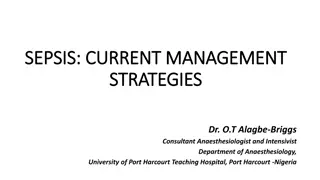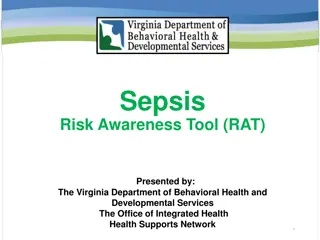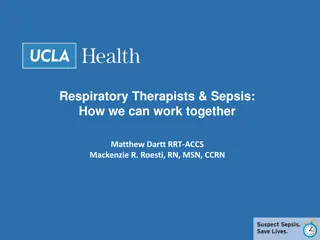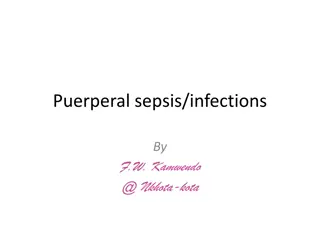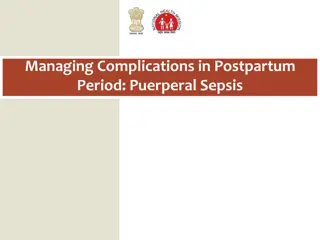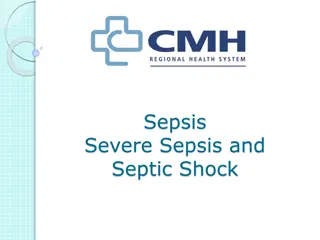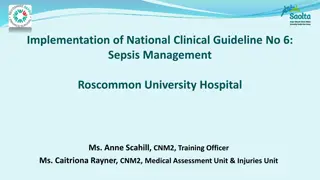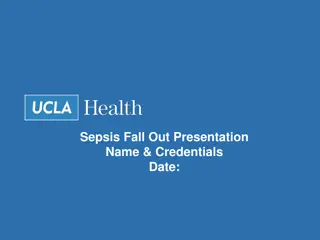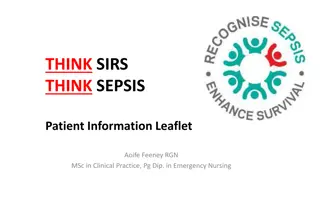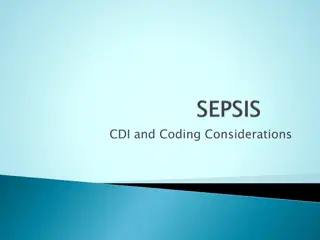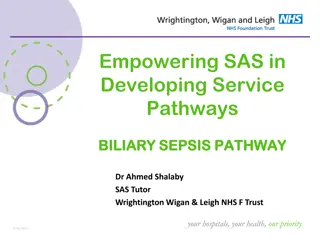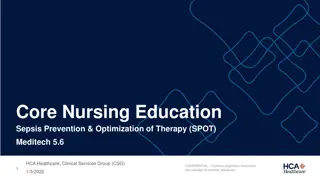Sepsis Emergency Presentations & Supportive Interventions
Nursing records audit revealed nurses' roles in emergency service & detecting sepsis. ED nurses screened patients, initiated workup, reduced treatment time. Objectives included developing nursing proforma, comprehensive assessment, and role articulation. Pilot study in November 2015. Results: 17/22 patients correctly identified with sepsis. Conclusions emphasized triage, triggering, and evidence-based assessments.
Download Presentation

Please find below an Image/Link to download the presentation.
The content on the website is provided AS IS for your information and personal use only. It may not be sold, licensed, or shared on other websites without obtaining consent from the author.If you encounter any issues during the download, it is possible that the publisher has removed the file from their server.
You are allowed to download the files provided on this website for personal or commercial use, subject to the condition that they are used lawfully. All files are the property of their respective owners.
The content on the website is provided AS IS for your information and personal use only. It may not be sold, licensed, or shared on other websites without obtaining consent from the author.
E N D
Presentation Transcript
Sepsis -Emergency Presentations & Supporting Interventions & Strategies Sarah Watkins Nurse Researcher/Phd candidate 3RD NATIONAL SEPSIS SUMMIT, DUBLIN CASTLE, 20TH SEPT '16
Background A retrospective audit 300 samples of nursing records (ADULTS) in the November 2014 1. Comprehensive assessment 2. Clear articulation of ED nurse s role 3. Integrated evidence base
Question How did nurses contribute to the emergency service? What were ED nurses doing to help in detecting Sepsis?
ED Nurse Screening to identify patients who have Sepsis Initiating the diagnostic workup Reducing door to needle time for administration of intravenous antibiotics (Bruce et al. 2015, Gatewood et al. 2015)
Objectives 1. Develop a Nursing Proforma 2. Comprehensive Assessment 3. Integration of best evidence 4. Articulate the ED nurse s role 5. Capture /important data time to blood cultures, time to first lactate and antimicrobials. detection rate time to
Methods Pilot of Nursing Proforma (Adults) November 2015
Methods NewnursingdocAUG1.pdf
Results Sample : 22 Inclusion Criteria : 10% of all Adult patients who presented with suspicion of or confirmed infection in a 2 week period to ED in UHL. The sample was randomly selected from this criteria. Exclusion Criteria : Paediatric patients, Pregnant women, Post-partum women up to 42 days.
Results 17/22 screened for and correctly identified as Sepsis 5/22 non compliance patients were
SEPSIS SIX 17 fluids 17 Blood cultures 16 Bloods 15 Antimicrobials 10 Oxygen 07 Urine output
Conclusions Triage Trigger/Trolley Trigger Screening Comprehensive, standardised, evidence based assessment Template for new/inexperienced ED nurses Promotes seamless care transitions
Acute Services Public Health Older people Mental Health Midwifery Intellectual disability Childrens
Future Plan Falls Risk Sepsis Emergency Service
References Bruce, H.R., Maiden, J., Fedullo, P.F. & Kim, S.C. (2015) Impact of Nurse Initiated ED Sepsis Protocol on Compliance With Sepsis Bundles, Time to Initial Antibiotic Administration, And In-Hospital Mortality , Journal of Emergency Nursing, 41(2), p. 130-137. Gatewood, M., Wemple, M., Greco. S., Kritek, P.A. & Durvasula, R. (2015) A quality improvement project to improve early sepsis care in the emergency department {online]24. Available@http://qualitysafety.bmj.com/content/24/12/787#BIBL[Accessed : 2nd July 2016]. Ireland. HSE (2015) Guiding Framework for the Implementation of Nursing and Midwifery Quality Care Metrics in the Health Service Executive. Dublin:HSE. Ireland. DOH (2014) Sepsis Management National Clinical Guideline No. 6. Dublin: DOH.


